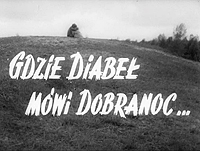 Gdzie diabeł mówi dobranoc
Gdzie diabeł mówi dobranoc
Poland, 1956, black and white, 11 mins
The first professional film by then recent film-school graduates Kazimierz Karabasz and Władysław Ślesicki, Where the Devil Says Goodnight is considered one of the key films of the ‘black series’ of documentaries that opened a debate about Poland’s social problems in the mid-1950s. However, it’s quite different in tone and content from the in-your-face shock-tactic approach of Jerzy Hoffman and Edward Skórzewski in Look Out, Hooligans! (Uwaga chuligani!, 1955) and The Children Accuse (Dzieci oskarżają, 1956). While they thrust the viewer into the thick of the action from the start, Karabasz and Ślesicki prefer to open with a slow pan across what initially appears to be a rural landscape, gradually revealing the buildings of Targówek, the film’s location – “the forgotten district of Warsaw”, according to the commentary (read by Tadeusz Łomnicki, the lead in Wajda’s A Generation the previous year).
In 1949, construction began on Targówek’s House of Culture, despite an unresolved controversy of what it was actually for, and whether it should be a greater priority than providing decent flats for the locals. Years pass, more plans are drawn up, walls are constructed and demolished – and by 1956, eight years after the foundations were first dug, the House of Culture is just as much of a building site as ever, offering just a tiny, cramped gym as a minuscule part of the original prospectus.

Amateur dramatics rehearsals are conducted in the same space as table tennis games and even pigeon fancying, not to mention meetings of the social committee to allocate who does what when – and as they deliberate, the original drawings appear on screen to show what they were promised. The “cultural revolution” in Targówek amounts to a travelling cinema that visits once a month. “Who is responsible for this?” asks the commentary, and is given no answer, as hooligans similar to the ones in Hoffman and Skórzewski’s film menace a young woman in the dimly-lit night-time streets.
However, Karabasz later admitted that he and Ślesicki were only marginally interested in the question of cultural provision in Targówek: it was just a convenient excuse to get permission to shoot there. Their film’s real value lies in its seemingly unvarnished presentation of the lives of those forced to live in Targówek: the marketplace as the centre for local gossip, the boys huddled together for a smoke in the Jewish cemetery (or, as popular local slang would have it, the Cholera Cemetery, presumably after the disease that carried off most of its inhabitants), the people filling their buckets with water from a communal tap, teenagers of both sexes meeting each other for trysts by the railway tracks (some more mutually consenting than others), a man helping his paralytically drunk friend down the street… into another bar.
In contrast to the slam-bang editing of Hoffman and Skórzewski the takes are longer and more measured, the setups less contrived, the sense of lives as they are actually lived far stronger, for all the signs of postproduction manipulation. A case in point: the gossiping housewives sequence was clearly shot at a different time to the recording of the unsynchronised soundtrack – but this deserves credit for attempting what in terms of Polish cinema seems to have been an unusually experimental approach to onscreen narration (albeit one familiar in British documentaries of two decades earlier: Paul Rotha attempted something similar in his 1935 film Shipyard when he superimposed the shipbuilders’ sometimes subversive thoughts over footage of them at work). The only music is a folksong, which Mikołaj Jazdon’s note in the booklet accompanying PWA’s DVD edition identifies as ‘Jam złodziej czarodziej’ (‘I am a Crook and a Conjurer’).

In terms of the film’s underlying message, Karabasz and Ślesicki eschew direct finger-pointing – “we” are apparently to blame for deceiving the people of Targówek, not any specific planning body. If one hadn’t been told, one would never have guessed that this film was shot in Warsaw: the wooden shacks and mudbath roads seem to come from somewhere much more rural. If contemporary reactions are any guide, the message got through: the film’s initial audiences and critics were genuinely shocked to be exposed to the reality behind years of utopian rhetoric of a kind that undoubtedly accompanied the original announcement about Targówek’s House of Culture.
- Director/script: Kazimierz Karabasz, Władysław Ślesicki
- Camera: Stanisław Niedbalski
- Sound: Halina Paszkowska
- Narration: Tadeusz Łomnicki
- Production Company: Wytwórnia Filmów Dokumentalnych (Documentary Film Studio)
The film is included on PWA’s Polish School of the Documentary: The Black Series double-DVD set (Region 0 PAL). PWA’s source print is a little battered, but the transfer is fine. One minor complaint about the subtitles is that they leave the phrase meaning ‘Cholera Cemetery’ in the original Polish, though in mitigation they make a fair stab at translating the lyrics of the opening solo song, at least when it’s not interrupted by narration. There are also a few typos, one of which charmingly renders ‘hooligans’ as the original Slavic ‘chooligans’.